Beyond Resistance: Tolerance and Resilience of Bacteria to Photodynamic and Oxidative Stress
Abstract
1. Introduction
- i
- clearly define and differentiate tolerance and resilience in the context of ROS-generating treatments;
- ii.
- outline their molecular and regulatory mechanisms;
- iii.
- highlight areas of mechanistic overlap and cross-protection;
- iv.
- discuss the implications of these traits for the efficacy and design of next-generation photonic antimicrobial interventions.
2. Photodynamic and Oxidative Stress in Bacteria
3. Mechanisms of Tolerance
4. Mechanisms of Resilience
5. Cross-Talk and Mechanistic Overlap
6. Reinterpreting Phototreatment Outcomes: Is Resilience the Missing Piece?
7. Resilience, Tolerance, and Resistance in the Context of Oxidative Phototreatments
8. Materials and Methods
Literature Search Strategy
9. Conclusions and Future Perspectives
Funding
Institutional Review Board Statement
Informed Consent Statement
Data Availability Statement
Acknowledgments
Conflicts of Interest
Abbreviations
| aBL | antimicrobial blue light |
| aPDI | antimicrobial photodynamic inactivation |
| CFU | colony-forming unit |
| MB | methylene blue |
| MDK | minimal duration of killing |
| MIC | minimal inhibitory concentration |
| NADH | nicotinamide adenine dinucleotide (reduced form) |
| NADPH | nicotinamide adenine dinucleotide phosphate (reduced form); |
| OD | optical density |
| PMF | proton motive force |
| PPP | pentose phosphate pathway |
| (p)ppGpp | guanosine tetraphosphate/pentaphosphate |
| qPCR | quantitative polymerase chain reaction |
| RB | rose bengal |
| RNS | reactive nitrogen species |
| ROS | reactive oxygen species |
| RNA-seq | RNA sequencing |
| TBO | toluidine blue O |
References
- Dai, T.; Huang, Y.Y.; Hamblin, M.R. Photodynamic therapy for localized infections—State of the art. Photodiagnosis Photodyn. Ther. 2009, 6, 170–188. [Google Scholar] [CrossRef] [PubMed]
- Durantini, E.N. New insights into the antimicrobial blue light inactivation of Candida albicans. Virulence 2016, 7, 493–494. [Google Scholar] [CrossRef]
- Hamblin, M.R. Antimicrobial photodynamic inactivation: A bright new technique to kill resistant microbes. Curr. Opin. Microbiol. 2016, 33, 67–73. [Google Scholar] [CrossRef]
- Wang, Y.; Wang, Y.; Wang, Y.; Murray, C.K.; Hamblin, M.R.; Hooper, D.C.; Dai, T. Antimicrobial blue light inactivation of pathogenic microbes: State of the art. Drug Resist. Updates 2017, 33–35, 1–22. [Google Scholar] [CrossRef]
- Kashef, N.; Huang, Y.Y.; Hamblin, M.R. Advances in antimicrobial photodynamic inactivation at the nanoscale. Nanophotonics 2017, 6, 853–879. [Google Scholar] [CrossRef]
- Wozniak, A.; Grinholc, M. Combined antimicrobial activity of photodynamic inactivation and antimicrobials–state of the art. Front. Microbiol. 2018, 9, 930. [Google Scholar] [CrossRef]
- Hadi, J.; Wu, S.; Brightwell, G. Antimicrobial blue light versus pathogenic bacteria: Mechanism, application in the food industry, hurdle technologies and potential resistance. Foods 2020, 9, 1895. [Google Scholar] [CrossRef]
- Ghate, V.S.; Zhou, W.; Yuk, H.G. Perspectives and trends in the application of photodynamic inactivation for microbiological food safety. Compr. Rev. Food Sci. Food Saf. 2019, 18, 402–424. [Google Scholar] [CrossRef]
- Leanse, L.G.; Dos Anjos, C.; Mushtaq, S.; Dai, T. Antimicrobial blue light: A ‘Magic Bullet’for the 21st century and beyond? Adv. Drug Deliv. Rev. 2022, 180, 114057. [Google Scholar] [CrossRef]
- Sheng, L.; Li, X.; Wang, L. Photodynamic inactivation in food systems: A review of its application, mechanisms, and future perspective. Trends Food Sci. Technol. 2022, 124, 167–181. [Google Scholar] [CrossRef]
- Haridas, D.; Atreya, C.D. The microbicidal potential of visible blue light in clinical medicine and public health. Front. Med. 2022, 9, 905606. [Google Scholar] [CrossRef] [PubMed]
- Dos Anjos, C.; Leanse, L.G.; Ribeiro, M.S.; Sellera, F.P.; Dropa, M.; Arana-Chavez, V.E.; Lincopan, N.; Baptista, M.S.; Pogliani, F.C.; Dai, T.; et al. New insights into the bacterial targets of antimicrobial blue light. Microbiol. Spectr. 2023, 11, e02833-22. [Google Scholar] [CrossRef] [PubMed]
- Ozdemir, G.D.; Dos Anjos, C.; Ozdemir, M.A.; Leanse, L.G.; Dai, T. Lights out for Superbugs: Is antimicrobial blue light a potential approach for future infection Control? Adv. Drug Deliv. Rev. 2025, 224, 115654. [Google Scholar] [CrossRef]
- Maisch, T. Resistance in antimicrobial photodynamic inactivation of bacteria. Photochem. Photobiol. Sci. 2015, 14, 1518–1526. [Google Scholar] [CrossRef]
- Guffey, J.S.; Payne, W.; Jones, T.; Martin, K. Evidence of resistance development by Staphylococcus aureus to an in vitro, multiple stage application of 405 nm light from a supraluminous diode array. Photomed. Laser Surg. 2013, 31, 179–182. [Google Scholar] [CrossRef]
- Rapacka-Zdonczyk, A.; Wozniak, A.; Pieranski, M.; Woziwodzka, A.; Bielawski, K.P.; Grinholc, M. Development of Staphylococcus aureus tolerance to antimicrobial photodynamic inactivation and antimicrobial blue light upon sub-lethal treatment. Sci. Rep. 2019, 9, 9423. [Google Scholar] [CrossRef]
- Rapacka-Zdonczyk, A.; Wozniak, A.; Kruszewska, B.; Waleron, K.; Grinholc, M. Can gram-negative bacteria develop resistance to antimicrobial blue light treatment? Int. J. Mol. Sci. 2021, 22, 11579. [Google Scholar] [CrossRef]
- Snell, S.B.; Gill, A.L.; Haidaris, C.G.; Foster, T.H.; Baran, T.M.; Gill, S.R. Staphylococcus aureus tolerance and genomic response to photodynamic inactivation. Msphere 2021, 6, 10–1128. [Google Scholar] [CrossRef]
- Girvan, M.S.; Campbell, C.D.; Killham, K.; Prosser, J.I.; Glover, L.A. Bacterial diversity promotes community stability and functional resilience after perturbation. Environ. Microbiol. 2005, 7, 301–313. [Google Scholar] [CrossRef]
- Brauner, A.; Fridman, O.; Gefen, O.; Balaban, N.Q. Distinguishing between resistance, tolerance and persistence to antibiotic treatment. Nat. Rev. Microbiol. 2016, 14, 320–330. [Google Scholar] [CrossRef] [PubMed]
- Trastoy, R.; Manso, T.; Fernández-García, L.; Blasco, L.; Ambroa, A.; Pérez Del Molino, M.L.; Bou, G.; García-Contreras, R.; Wood, T.K.; Tomás, M. Mechanisms of bacterial tolerance and persistence in the gastrointestinal and respiratory environments. Clin. Microbiol. Rev. 2018, 31, e00023-18. [Google Scholar] [CrossRef]
- Levin-Reisman, I.; Ronin, I.; Gefen, O.; Braniss, I.; Shoresh, N.; Balaban, N.Q. Antibiotic tolerance facilitates the evolution of resistance. Science 2017, 355, 826–830. [Google Scholar] [CrossRef]
- Carvalho, G.; Forestier, C.; Mathias, J.D. Antibiotic resilience: A necessary concept to complement antibiotic resistance? Proc. R. Soc. B 2019, 286, 20192408. [Google Scholar] [CrossRef] [PubMed]
- Guldimann, C.; Boor, K.J.; Wiedmann, M.; Guariglia-Oropeza, V. Resilience in the face of uncertainty: Sigma factor B fine-tunes gene expression to support homeostasis in Gram-positive bacteria. Appl. Environ. Microbiol. 2016, 82, 4456–4469. [Google Scholar] [CrossRef] [PubMed]
- Dwyer, D.J.; Collins, J.J.; Walker, G.C. Unraveling the physiological complexities of antibiotic lethality. Annu. Rev. Pharmacol. Toxicol. 2015, 55, 313–332. [Google Scholar] [CrossRef]
- Yang, H.; He, M.; Wu, C. Cross protection of lactic acid bacteria during environmental stresses: Stress responses and underlying mechanisms. Lwt 2021, 144, 111203. [Google Scholar] [CrossRef]
- Chapman, J.S. Disinfectant resistance mechanisms, cross-resistance, and co-resistance. Int. Biodeterior. Biodegrad. 2003, 51, 271–276. [Google Scholar] [CrossRef]
- Gnanadhas, D.P.; Marathe, S.A.; Chakravortty, D. Biocides–resistance, cross-resistance mechanisms and assessment. Expert Opin. Investig. Drugs 2013, 22, 191–206. [Google Scholar] [CrossRef]
- Salisbury, A.M.; Woo, K.; Sarkar, S.; Schultz, G.; Malone, M.; Mayer, D.O.; Percival, S.L. Tolerance of Biofilms to Antimicrobials and Significance to Antibiotic Resistance in Wounds. Surg. Technol. Int. 2018, 33, 59–66. [Google Scholar]
- de Souza Cândido, E.; de Barros, E.; Cardoso, M.H.; Franco, O.L. Bacterial cross-resistance to anti-infective compounds. Is it a real problem? Curr. Opin. Pharmacol. 2019, 48, 76–81. [Google Scholar] [CrossRef]
- Kruszewska-Naczk, B.; Pikulik-Arif, P.; Grinholc, M.; Rapacka-Zdonczyk, A. Antibacterial blue light is a promising tool for inactivating Escherichia coli in the food sector due to its low risk of cross-stress tolerance. Chem. Biol. Technol. Agric. 2024, 11, 126. [Google Scholar] [CrossRef]
- Imlay, J.A. The molecular mechanisms and physiological consequences of oxidative stress: Lessons from a model bacterium. Nat. Rev. Microbiol. 2013, 11, 443–454. [Google Scholar] [CrossRef]
- Fang, F.C. Antimicrobial reactive oxygen and nitrogen species: Concepts and controversies. Nat. Rev. Microbiol. 2004, 2, 820–832. [Google Scholar] [CrossRef]
- Andrés, C.M.C.; Pérez de la Lastra, J.M.; Juan, C.A.; Plou, F.J.; Pérez-Lebeña, E. The role of reactive species on innate immunity. Vaccines 2022, 10, 1735. [Google Scholar] [CrossRef]
- Martinvalet, D.; Walch, M. The role of reactive oxygen species in protective immunity. Front. Immunol. 2022, 12, 832946. [Google Scholar] [CrossRef]
- Dwyer, D.J.; Belenky, P.A.; Yang, J.H.; MacDonald, I.C.; Martell, J.D.; Takahashi, N.; Chan, C.T.Y.; Lobritz, M.A.; Braff, D.; Schwarz, E.G.; et al. Antibiotics induce redox-related physiological alterations as part of their lethality. Proc. Natl. Acad. Sci. USA 2014, 111, E2100–E2109. [Google Scholar] [CrossRef]
- Przygoda, M.; Bartusik-Aebisher, D.; Dynarowicz, K.; Cieślar, G.; Kawczyk-Krupka, A.; Aebisher, D. Cellular mechanisms of singlet oxygen in photodynamic therapy. Int. J. Mol. Sci. 2023, 24, 16890. [Google Scholar] [CrossRef]
- Szewczyk, G.; Mokrzyński, K.; Sarna, T. Generation of singlet oxygen inside living cells: Correlation between phosphorescence decay lifetime, localization and outcome of photodynamic action. Photochem. Photobiol. Sci. 2024, 23, 1673–1685. [Google Scholar] [CrossRef]
- Asad, N.R.; Asad, L.M.B.O.; Almeida, C.E.B.D.; Felzenszwalb, I.; Cabral-Neto, J.B.; Leitão, A.C. Several pathways of hydrogen peroxide action that damage the E. coli genome. Genet. Mol. Biol. 2004, 27, 291–303. [Google Scholar] [CrossRef][Green Version]
- Imlay, J.A. Transcription factors that defend bacteria against reactive oxygen species. Annu. Rev. Microbiol. 2015, 69, 93–108. [Google Scholar] [CrossRef]
- Vatansever, F.; de Melo, W.C.; Avci, P.; Vecchio, D.; Sadasivam, M.; Gupta, A.; Chandran, R.; Karimi, M.; Parizotto, N.A.; Yin, R.; et al. Antimicrobial strategies centered around reactive oxygen species–bactericidal antibiotics, photodynamic therapy, and beyond. FEMS Microbiol. Rev. 2013, 37, 955–989. [Google Scholar] [CrossRef]
- Balaban, N.Q.; Helaine, S.; Lewis, K.; Ackermann, M.; Aldridge, B.; Andersson, D.I.; Brynildsen, M.P.; Bumann, D.; Camilli, A.; Collins, J.J.; et al. Definitions and guidelines for research on antibiotic persistence. Nat. Rev. Microbiol. 2019, 17, 441–448, Erratum in Nat. Rev. Microbiol. 2019, 17, 460.. [Google Scholar] [CrossRef]
- Brauner, A.; Shoresh, N.; Fridman, O.; Balaban, N.Q. An experimental framework for quantifying bacterial tolerance. Biophys. J. 2017, 112, 2664–2671. [Google Scholar] [CrossRef]
- Ahmad, Z.; Klinkenberg, L.G.; Pinn, M.L.; Fraig, M.M.; Peloquin, C.A.; Bishai, W.R.; Nuermberger, E.L.; Grosset, J.H.; Karakousis, P.C. Biphasic kill curve of isoniazid reveals the presence of drug-tolerant, not drug-resistant, Mycobacterium tuberculosis in the guinea pig. J. Infect. Dis. 2009, 200, 1136–1143. [Google Scholar] [CrossRef]
- Kim, J.S.; Wood, T.K. Tolerant, growing cells from nutrient shifts are not persister cells. Mbio 2017, 8, e00354-17. [Google Scholar] [CrossRef]
- Prax, M.; Bertram, R. Metabolic aspects of bacterial persisters. Front. Cell. Infect. Microbiol. 2014, 4, 148. [Google Scholar] [CrossRef]
- Zhou, Y.; Liao, H.; Pei, L.; Pu, Y. Combatting persister cells: The daunting task in post-antibiotics era. Cell Insight 2023, 2, 100104. [Google Scholar] [CrossRef]
- Cabral, D.J.; Wurster, J.I.; Belenky, P. Antibiotic persistence as a metabolic adaptation: Stress, metabolism, the host, and new directions. Pharmaceuticals 2018, 11, 14. [Google Scholar] [CrossRef]
- Yan, J.; Bassler, B.L. Surviving as a community: Antibiotic tolerance and persistence in bacterial biofilms. Cell Host Microbe 2019, 26, 15–21. [Google Scholar] [CrossRef]
- Niu, H.; Gu, J.; Zhang, Y. Bacterial persisters: Molecular mechanisms and therapeutic development. Signal Transduct. Target. Ther. 2024, 9, 174. [Google Scholar] [CrossRef]
- Rahman, K.T.; Amaratunga, R.; Butzin, X.Y.; Singh, A.; Hossain, T.; Butzin, N.C. Rethinking dormancy: Antibiotic persisters are metabolically active, non-growing cells. Int. J. Antimicrob. Agents 2025, 65, 107386. [Google Scholar] [CrossRef]
- Shan, Y.; Brown Gandt, A.; Rowe, S.E.; Deisinger, J.P.; Conlon, B.P.; Lewis, K. ATP-dependent persister formation in Escherichia coli. Mbio 2017, 8, e02267-16. [Google Scholar] [CrossRef]
- Lemire, J.; Alhasawi, A.; Appanna, V.P.; Tharmalingam, S.; Appanna, V.D. Metabolic defence against oxidative stress: The road less travelled so far. J. Appl. Microbiol. 2017, 123, 798–809. [Google Scholar] [CrossRef]
- Singh, R.; Mailloux, R.J.; Puiseux-Dao, S.; Appanna, V.D. Oxidative stress evokes a metabolic adaptation that favors increased NADPH synthesis and decreased NADH production in Pseudomonas fluorescens. J. Bacteriol. 2007, 189, 6665–6675. [Google Scholar] [CrossRef]
- Li, X.Z.; Plésiat, P.; Nikaido, H. The challenge of efflux-mediated antibiotic resistance in Gram-negative bacteria. Clin. Microbiol. Rev. 2015, 28, 337–418. [Google Scholar] [CrossRef]
- Grinholc, M.; Zawacka-Pankau, J.; Gwizdek-Wiśniewska, A.; Bielawski, K.P. Evaluation of the Role of the Pharmacological Inhibition of Staphylococcus aureus Multidrug Resistance Pumps and the Variable Levels of the Uptake of the Sensitizer in the Strain-Dependent Response of Staphylococcus aureus to PPArg2-Based Photodynamic Inactivation. Photochem. Photobiol. 2010, 86, 1118–1126. [Google Scholar]
- Zhang, R.; Hartline, C.; Zhang, F. The ability in managing reactive oxygen species affects Escherichia coli persistence to ampicillin after nutrient shifts. mSystems 2024, 9, e01295-24. [Google Scholar] [CrossRef]
- Zhao, X.; Drlica, K. Reactive oxygen species and the bacterial response to lethal stress. Curr. Opin. Microbiol. 2014, 21, 1–6. [Google Scholar] [CrossRef]
- Wang, X.; Wood, T.K. Toxin-antitoxin systems influence biofilm and persister cell formation and the general stress response. Appl. Environ. Microbiol. 2011, 77, 5577–5583. [Google Scholar] [CrossRef]
- Paul, P.; Sahu, B.R.; Suar, M. Plausible role of bacterial toxin–antitoxin system in persister cell formation and elimination. Mol. Oral Microbiol. 2019, 34, 97–107. [Google Scholar] [CrossRef]
- Fraikin, N.; Rousseau, C.J.; Goeders, N.; Van Melderen, L. Reassessing the role of the type II MqsRA toxin-antitoxin system in stress response and biofilm formation: mqsA is transcriptionally uncoupled from mqsR. Mbio 2019, 10, e02678-19. [Google Scholar] [CrossRef]
- Kędzierska, B.; Hayes, F. Emerging roles of toxin-antitoxin modules in bacterial pathogenesis. Molecules 2016, 21, 790. [Google Scholar] [CrossRef]
- Maisonneuve, E.; Gerdes, K. Molecular mechanisms underlying bacterial persisters. Cell 2014, 157, 539–548. [Google Scholar] [CrossRef]
- Zou, J.; Peng, B.; Qu, J.; Zheng, J. Are bacterial persisters dormant cells only? Front. Microbiol. 2022, 12, 708580. [Google Scholar] [CrossRef]
- Edelmann, D.; Berghoff, B.A. Type I toxin-dependent generation of superoxide affects the persister life cycle of Escherichia coli. Sci. Rep. 2019, 9, 14256. [Google Scholar] [CrossRef]
- Yuan, S.; Shen, Y.; Quan, Y.; Gao, S.; Zuo, J.; Jin, W.; Li, R.; Li, Y.; Wang, Y.; Wang, Y. Molecular mechanism and application of emerging technologies in study of bacterial persisters. BMC Microbiol. 2024, 24, 480. [Google Scholar] [CrossRef]
- Wu, N.; He, L.; Cui, P.; Wang, W.; Yuan, Y.; Liu, S.; Xu, T.; Zhang, S.; Wu, J.; Zhang, W.; et al. Ranking of persister genes in the same Escherichia coli genetic background demonstrates varying importance of individual persister genes in tolerance to different antibiotics. Front. Microbiol. 2015, 6, 1003. [Google Scholar] [CrossRef]
- Shi, X.; Zarkan, A. Bacterial survivors: Evaluating the mechanisms of antibiotic persistence. Microbiology 2022, 168, 001266. [Google Scholar] [CrossRef]
- Svenningsen, M.S.; Veress, A.; Harms, A.; Mitarai, N.; Semsey, S. Birth and resuscitation of (p) ppGpp induced antibiotic tolerant persister cells. Sci. Rep. 2019, 9, 6056. [Google Scholar] [CrossRef]
- Van den Bergh, B.; Fauvart, M.; Michiels, J. Formation, physiology, ecology, evolution and clinical importance of bacterial persisters. FEMS Microbiol. Rev. 2017, 41, 219–251. [Google Scholar] [CrossRef]
- Janion, C. Inducible SOS response system of DNA repair and mutagenesis in Escherichia coli. Int. J. Biol. Sci. 2008, 4, 338. [Google Scholar] [CrossRef]
- Maslowska, K.H.; Makiela-Dzbenska, K.; Fijalkowska, I.J. The SOS system: A complex and tightly regulated response to DNA damage. Environ. Mol. Mutagen. 2019, 60, 368–384. [Google Scholar] [CrossRef]
- Misra, H.S.; Rajpurohit, Y.S. DNA damage response and cell cycle regulation in bacteria: A twist around the paradigm. Front. Microbiol. 2024, 15, 1389074. [Google Scholar] [CrossRef]
- Ajiboye, T.O.; Skiebe, E.; Wilharm, G. Contributions of RecA and RecBCD DNA repair pathways to the oxidative stress response and sensitivity of Acinetobacter baumannii to antibiotics. Int. J. Antimicrob. Agents 2018, 52, 629–636. [Google Scholar] [CrossRef]
- Lima-Noronha, M.A.; Fonseca, D.L.; Oliveira, R.S.; Freitas, R.R.; Park, J.H.; Galhardo, R.S. Sending out an SOS-the bacterial DNA damage response. Genet. Mol. Biol. 2022, 45, e20220107. [Google Scholar] [CrossRef]
- Henry, C.; Loiseau, L.; Vergnes, A.; Vertommen, D.; Merida-Floriano, A.; Chitteni-Pattu, S.; Wood, E.A.; Casadesús, J.; Cox, M.M.; Barras, F.; et al. Redox controls RecA protein activity via reversible oxidation of its methionine residues. Elife 2021, 10, e63747. [Google Scholar] [CrossRef]
- Grinholc, M.; Rodziewicz, A.; Forys, K.; Rapacka-Zdonczyk, A.; Kawiak, A.; Domachowska, A.; Golunski, G.; Wolz, C.; Mesak, L.; Becker, K.; et al. Fine-tuning recA expression in Staphylococcus aureus for antimicrobial photoinactivation: Importance of photo-induced DNA damage in the photoinactivation mechanism. Appl. Microbiol. Biotechnol. 2015, 99, 9161–9176. [Google Scholar] [CrossRef]
- Susin, M.F.; Baldini, R.L.; Gueiros-Filho, F.; Gomes, S.L. GroES/GroEL and DnaK/DnaJ have distinct roles in stress responses and during cell cycle progression in Caulobacter crescentus. J. Bacteriol. 2006, 188, 8044–8053. [Google Scholar] [CrossRef]
- Cardoso, K.; Gandra, R.F.; Wisniewski, E.S.; Osaku, C.A.; Kadowaki, M.K.; Felipach-Neto, V.; Haus, L.F.A.; Simão, R.D.C.G. DnaK and GroEL are induced in response to antibiotic and heat shock in Acinetobacter baumannii. J. Med. Microbiol. 2010, 59, 1061–1068. [Google Scholar] [CrossRef]
- Figaj, D. The role of heat shock protein (Hsp) chaperones in environmental stress adaptation and virulence of plant pathogenic bacteria. Int. J. Mol. Sci. 2025, 26, 528. [Google Scholar] [CrossRef]
- Fourie, K.R.; Wilson, H.L. Understanding GroEL and DnaK stress response proteins as antigens for bacterial diseases. Vaccines 2020, 8, 773. [Google Scholar] [CrossRef]
- St. Denis, T.G.; Huang, L.; Dai, T.; Hamblin, M.R. Analysis of the bacterial heat shock response to photodynamic therapy-mediated oxidative stress. Photochem. Photobiol. 2011, 87, 707–713. [Google Scholar] [CrossRef]
- Alam, A.; Bröms, J.E.; Kumar, R.; Sjöstedt, A. The role of ClpB in bacterial stress responses and virulence. Front. Mol. Biosci. 2021, 8, 668910. [Google Scholar] [CrossRef] [PubMed]
- Ezraty, B.; Gennaris, A.; Barras, F.; Collet, J.F. Oxidative stress, protein damage and repair in bacteria. Nat. Rev. Microbiol. 2017, 15, 385–396. [Google Scholar] [CrossRef]
- Chautrand, T.; Souak, D.; Chevalier, S.; Duclairoir-Poc, C. Gram-negative bacterial envelope homeostasis under oxidative and nitrosative stress. Microorganisms 2022, 10, 924. [Google Scholar] [CrossRef] [PubMed]
- Lundstedt, E.; Kahne, D.; Ruiz, N. Assembly and maintenance of lipids at the bacterial outer membrane. Chem. Rev. 2020, 121, 5098–5123. [Google Scholar] [CrossRef]
- Nikaido, H. Multidrug resistance in bacteria. Annu. Rev. Biochem. 2009, 78, 119–146. [Google Scholar] [CrossRef]
- De Carvalho, C.C.; Caramujo, M.J. The various roles of fatty acids. Molecules 2018, 23, 2583. [Google Scholar] [CrossRef] [PubMed]
- Qi, Y.; Liu, H.; Chen, X.; Liu, L. Engineering microbial membranes to increase stress tolerance of industrial strains. Metab. Eng. 2019, 53, 24–34. [Google Scholar] [CrossRef] [PubMed]
- Chakraborty, S.; Liu, L.; Fitzsimmons, L.; Porwollik, S.; Kim, J.S.; Desai, P.; McClelland, M.; Vazquez-Torres, A. Glycolytic reprograming in Salmonella counters NOX2-mediated dissipation of ΔpH. Nat. Commun. 2020, 11, 1783. [Google Scholar] [CrossRef]
- Bhat, S.A.; Iqbal, I.K.; Kumar, A. Imaging the NADH: NAD+ homeostasis for understanding the metabolic response of Mycobacterium to physiologically relevant stresses. Front. Cell. Infect. Microbiol. 2016, 6, 145. [Google Scholar] [CrossRef]
- Meirelles, L.A.; Perry, E.K.; Bergkessel, M.; Newman, D.K. Bacterial defenses against a natural antibiotic promote collateral resilience to clinical antibiotics. PLoS Biol. 2021, 19, e3001093. [Google Scholar] [CrossRef]
- Reuven, N.B.; Tomer, G.; Livneh, Z. The mutagenesis proteins UmuD′ and UmuC prevent lethal frameshifts while increasing base substitution mutations. Mol. Cell 1998, 2, 191–199. [Google Scholar] [CrossRef]
- Pohland, S.; Vourvoutsiotou, J.; Brandtner, L.; Geißler, D.; Wiesmeth, S.; Scudlo, V.; Richter, P.; Burkovski, A.; Lebert, M. Chlorophyllin-Mediated Photodynamic Inactivation: Dosage and Time Dependency in the Inhibition of Bacillus subtilis. Microorganisms 2025, 13, 1189. [Google Scholar] [CrossRef] [PubMed]
- Pranjic, M.; Spät, P.; Curkovic, M.S.; Macek, B.; Gruic-Sovulj, I.; Mocibob, M. Resilience and proteome response of Escherichia coli to high levels of isoleucine mistranslation. Int. J. Biol. Macromol. 2024, 262, 130068. [Google Scholar] [CrossRef]
- Konovalova, A.; Kahne, D.E.; Silhavy, T.J. Outer membrane biogenesis. Annu. Rev. Microbiol. 2017, 71, 539–556. [Google Scholar] [CrossRef]
- Charoenwong, D.; Andrews, S.; Mackey, B. Role of rpoS in the development of cell envelope resilience and pressure resistance in stationary-phase Escherichia coli. Appl. Environ. Microbiol. 2011, 77, 5220–5229. [Google Scholar] [CrossRef]
- Christodoulou, D.; Link, H.; Fuhrer, T.; Kochanowski, K.; Gerosa, L.; Sauer, U. Reserve flux capacity in the pentose phosphate pathway enables Escherichia coli’s rapid response to oxidative stress. Cell Syst. 2018, 6, 569–578. [Google Scholar] [CrossRef] [PubMed]
- Macritchie, D.M.; Raivio, T.L. Envelope stress responses. EcoSal Plus 2009, 3, 10–1128. [Google Scholar] [CrossRef] [PubMed]
- Meredith, H.R.; Andreani, V.; Ma, H.R.; Lopatkin, A.J.; Lee, A.J.; Anderson, D.J.; Batt, G.; You, L. Applying ecological resistance and resilience to dissect bacterial antibiotic responses. Sci. Adv. 2018, 4, eaau1873. [Google Scholar] [CrossRef]
- Fridman, O.; Goldberg, A.; Ronin, I.; Shoresh, N.; Balaban, N.Q. Optimization of lag time underlies antibiotic tolerance in evolved bacterial populations. Nature 2014, 513, 418–421. [Google Scholar] [CrossRef]
- Bouillet, S.; Bauer, T.S.; Gottesman, S. RpoS and the bacterial general stress response. Microbiol. Mol. Biol. Rev. 2024, 88, e00151-22. [Google Scholar] [CrossRef] [PubMed]
- Hecker, M.; Pané-Farré, J.; Uwe, V. SigB-dependent general stress response in Bacillus subtilis and related gram-positive bacteria. Annu. Rev. Microbiol. 2007, 61, 215–236. [Google Scholar] [CrossRef] [PubMed]
- Dragosits, M.; Mozhayskiy, V.; Quinones-Soto, S.; Park, J.; Tagkopoulos, I. Evolutionary potential, cross-stress behavior and the genetic basis of acquired stress resistance in Escherichia coli. Mol. Syst. Biol. 2013, 9, 643. [Google Scholar] [CrossRef] [PubMed]
- Xiong, X.; Othmer, H.G.; Harcombe, W.R. Emergent antibiotic persistence in a spatially structured synthetic microbial mutualism. ISME J. 2024, 18, wrae075. [Google Scholar] [CrossRef]
- Almatroudi, A. Biofilm resilience: Molecular mechanisms driving antibiotic resistance in clinical contexts. Biology 2025, 14, 165. [Google Scholar] [CrossRef]
- Kruszewska-Naczk, B.; Grinholc, M.; Rapacka-Zdonczyk, A. Mimicking the Effects of Antimicrobial Blue Light: Exploring Single Stressors and Their Impact on Microbial Growth. Antioxidants 2024, 13, 1583. [Google Scholar] [CrossRef]
- Leanse, L.G.; Harrington, O.D.; Fang, Y.; Ahmed, I.; Goh, X.S.; Dai, T. Evaluating the potential for resistance development to antimicrobial blue light (at 405 nm) in Gram-negative bacteria: In vitro and in vivo studies. Front. Microbiol. 2018, 9, 2403. [Google Scholar] [CrossRef]
- Zhang, Y.; Zhu, Y.; Chen, J.; Wang, Y.; Sherwood, M.E.; Murray, C.K.; Vrahas, M.S.; Hooper, D.C.; Hamblin, M.R.; Dai, T. Antimicrobial blue light inactivation of Candida albicans: In vitro and in vivo studies. Virulence 2016, 7, 536–545. [Google Scholar] [CrossRef]
- Amin, R.M.; Bhayana, B.; Hamblin, M.R.; Dai, T. Antimicrobial blue light inactivation of Pseudomonas aeruginosa by photo-excitation of endogenous porphyrins: In vitro and in vivo studies. Lasers Surg. Med. 2016, 48, 562–568. [Google Scholar] [CrossRef]
- Tomb, R.M.; Maclean, M.; Coia, J.E.; MacGregor, S.J.; Anderson, J.G. Assessment of the potential for resistance to antimicrobial violet-blue light in Staphylococcus aureus. Antimicrob. Resist. Infect. Control. 2017, 6, 100. [Google Scholar] [CrossRef] [PubMed]
- Pieranski, M.; Sitkiewicz, I.; Grinholc, M. Increased photoinactivation stress tolerance of Streptococcus agalactiae upon consecutive sublethal phototreatments. Free Radic. Biol. Med. 2020, 160, 657–669. [Google Scholar] [CrossRef] [PubMed]
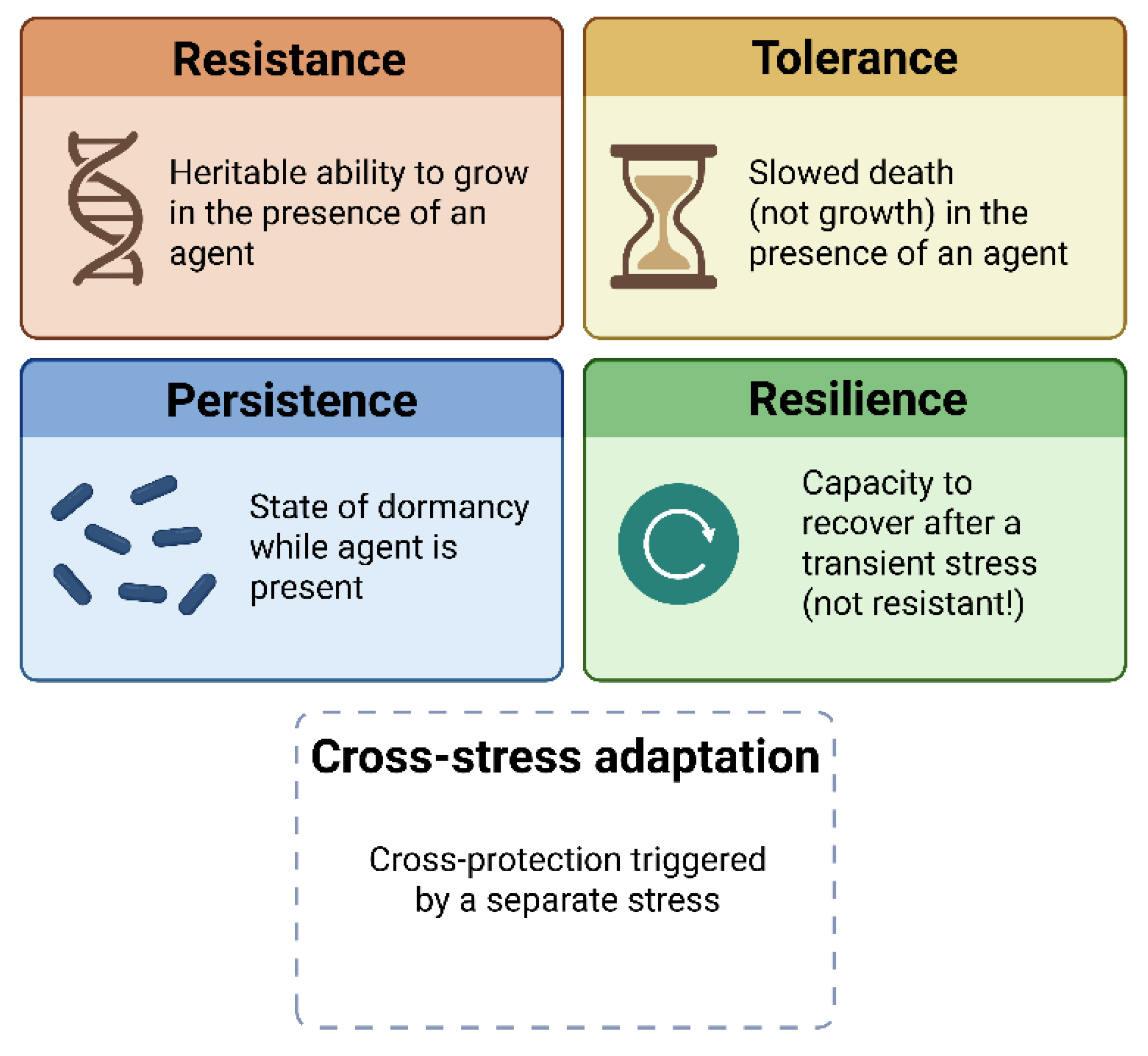
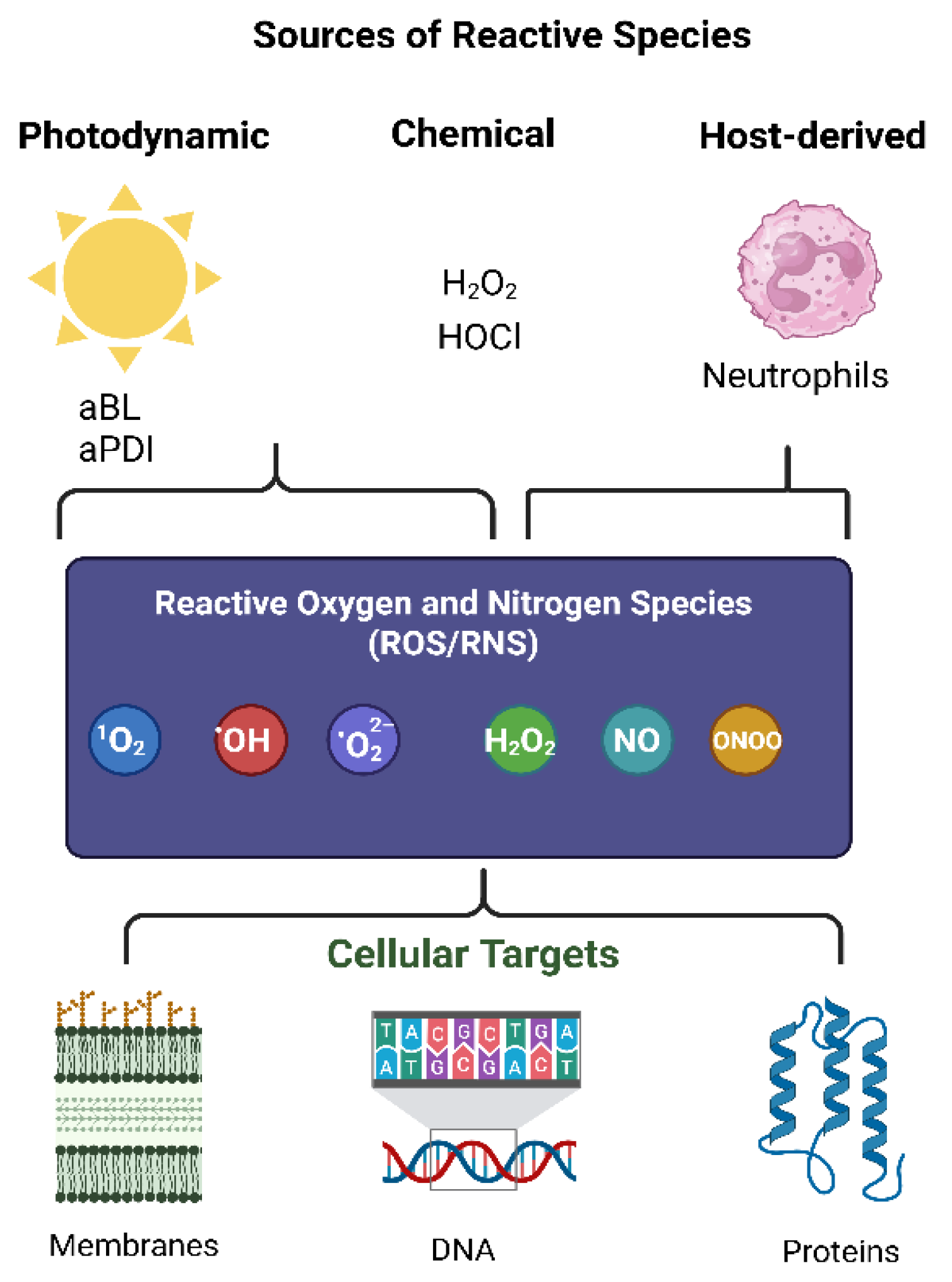
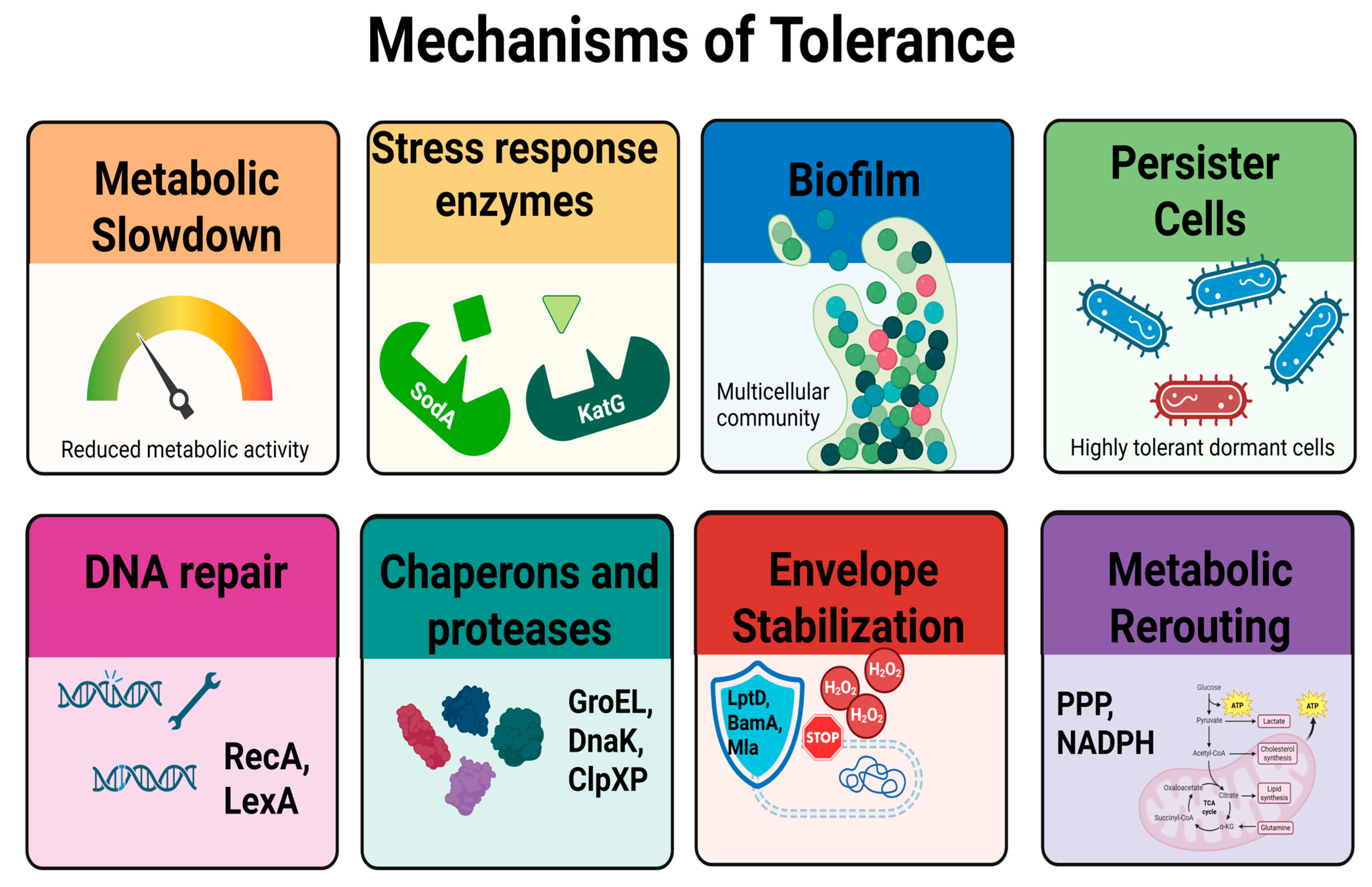
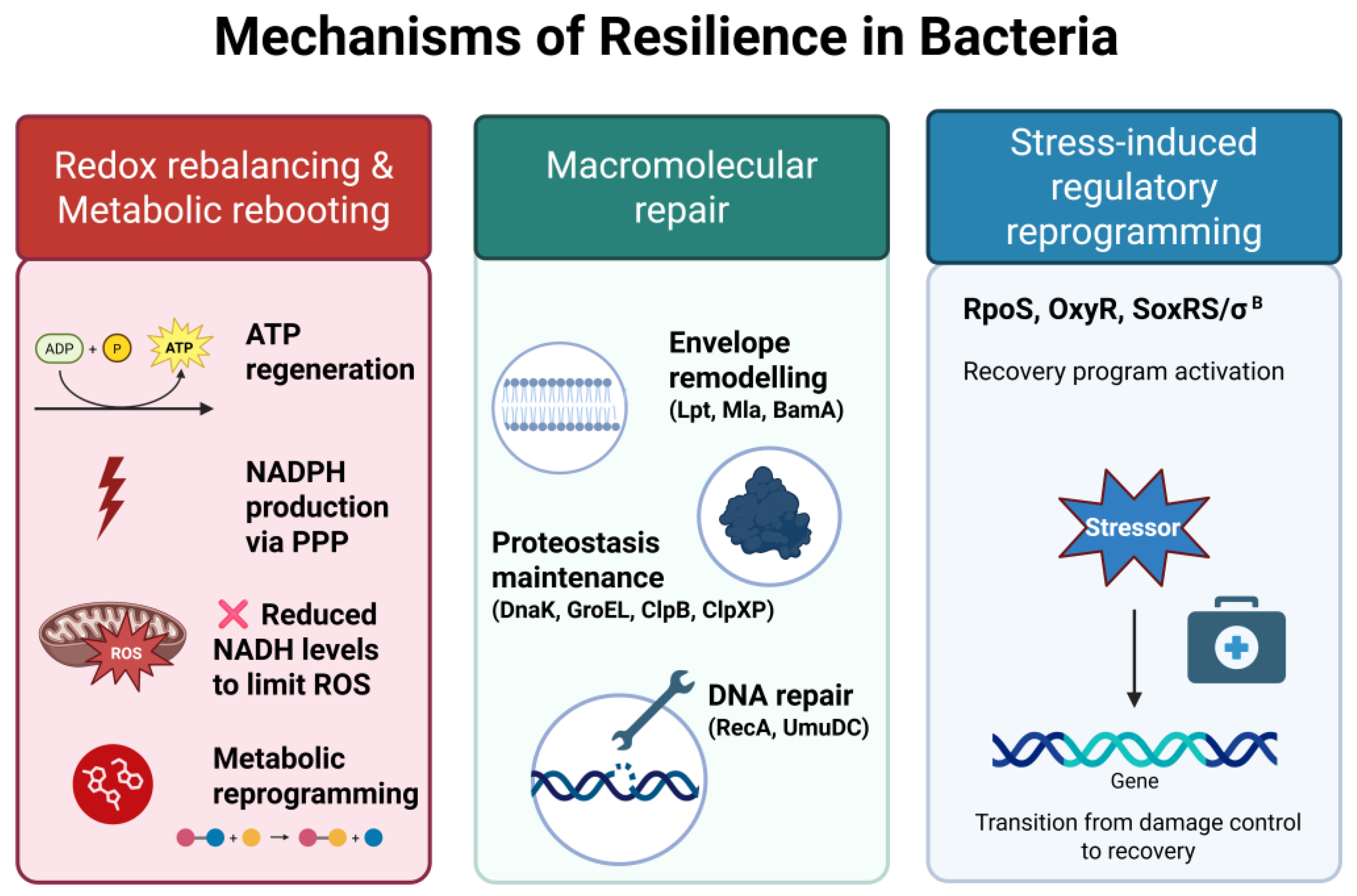
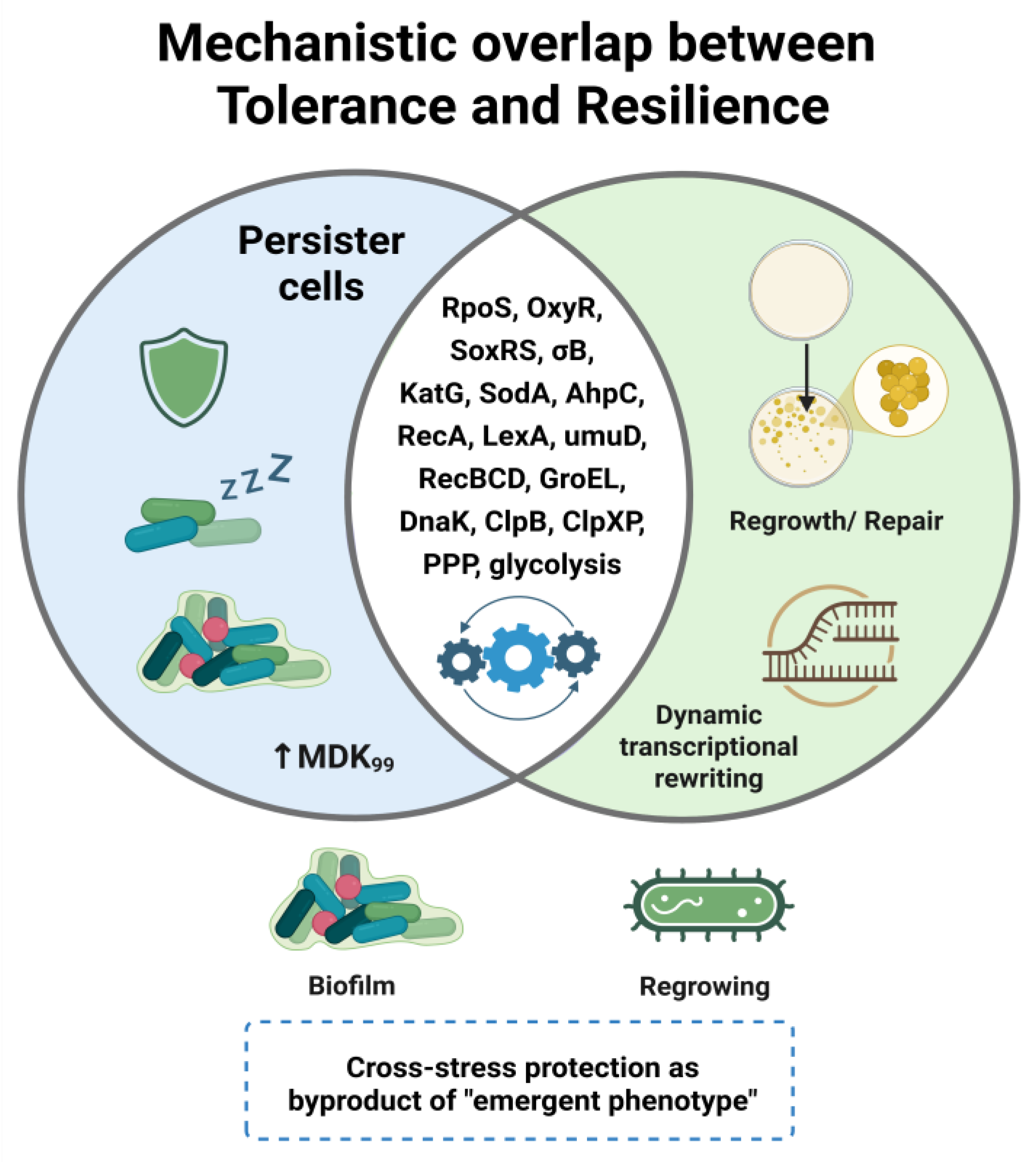

| Mechanism | Key Players | Role in Tolerance | Role in Resilience | References |
|---|---|---|---|---|
| Global stress regulators | RpoS, SoxRS, OxyR, σ^B | Dormancy, metabolic suppression, ROS mitigation | Repair coordination, redox balance, metabolic rebooting | [97,102,103] |
| Antioxidant enzymes | KatG, SodA/B, AhpC, Tpx, PerR (Gram+) | ROSs scavenging during stress exposure | Redox balance maintenance during recovery | [32,40,41,57,58] |
| DNA repair (SOS response) | RecA, LexA, UmuD, RecBCD | Genome stabilization under stress, mutagenesis | Replication restart and DNA repair after stress removal | [71,72,73,74,75,76,77,93] |
| Chaperones and proteases | GroEL, DnaK, ClpB, ClpXP, Lon, IbpA/B, Hsp33 | Prevention of protein aggregation | Protein refolding and proteome recovery | [78,79,80,81,82,83] |
| Efflux and envelope systems | Efflux: AcrAB–TolC, NorA, MexAB–OprM; Envelope: LptD, BamA, OmpF, Mla system | Reduction of intracellular toxic load, envelope stabilization | Outer membrane repair, PMF restoration | [55,56,85,86,87,96,99,106,107] |
| Metabolic adaptation | PPP, NADPH/NADH balance, glycolytic rerouting | Metabolic slowdown to reduce ROS formation | PPP upregulation for NADPH supply and repair | [53,54,90,91,98,100] |
| Persister/dormancy formation | (p)ppGpp, TA systems, RpoS | Entry into persistence, multidrug tolerance | Persister awakening and division restart | [20,42,43,44,45,46,47,48,49,50,51,52,59,60,61,62,63,64,65,66,67,68,69,70] |
| Species | Treatment | Observations | Original Interpretation | Possible Resilience Indicator | Reference |
|---|---|---|---|---|---|
| A. baumannii | aBL (10 repeated cycles) | Transient drop in efficacy at cycles 9, 16, and 17; full susceptibility restored in later cycles | No tolerance detected | Cycle-dependent fluctuation in killing efficacy; may reflect resilience-driven recovery | [108] |
| C. albicans | aBL (10 cycles) | Slight, temporary efficacy reduction at cycles 4–5; later cycles showed stable or increased susceptibility | No tolerance detected | Short-lived decline in susceptibility; possible physiological adjustment without heritable change | [109] |
| P. aeruginosa | aBL (10 cycles) | Overall stable killing across cycles, but transient reduction in efficacy at ~cycles 3–4, later restored | No tolerance detected | Short-lived dip in susceptibility may indicate resilience-type recovery | [110] |
| S. aureus | aBL (15 cycles) | Stable efficacy across all cycles; no cumulative loss observed | No tolerance detected | None detected; findings argue against resilience under repeated aBL stress. | [111] |
| E. coli | aBL (15 cycles) | Sustained delay in killing kinetics across repeated exposures; effect persisted even after subculturing | Stable tolerance detected | Tolerance rather than resilience; stability observed across passages | [17] |
| S. aureus | RB-mediated aPDI (20 cycles) | Progressive reduction in efficacy across cycles; stable tolerant phenotype maintained even after subculturing | Stable tolerance detected | Genetic alterations supporting long-term tolerance; not resilience | [16] |
| S. aureus | MB-mediated aPDI (7 cycles) | Progressive loss of efficacy; stable tolerant phenotype emerged. Cross-tolerance observed | Stable tolerance detected | Cross-tolerance across structurally related photosensitizers (MB and TBO) indicates genetic adaptation | [18] |
| Streptococcus agalactiae | RB-mediated aPDI (10 cycles) | Stable reduction in efficacy; tolerance persisted after 5 passages without selection | Stable tolerance detected | Genetic/physiological adaptations (↑ oxidative stress genes, SCVs, ↓ PS uptake) | [112] |
| Parameter | Description | Proposed Method | Distinguishes From | References |
|---|---|---|---|---|
| Recovery time after treatment | Time to reach OD600 threshold or CFU rebound after a defined exposure | Growth-curve monitoring (OD/time)/regrowth CFU | Tolerance (where the main change occurs during exposure, i.e., altered MDK) | [20,110] |
| Transient stress-response expression | Upregulation of oxidative/damage-response genes immediately after exposure that normalizes upon recovery | qPCR/RNA-seq at 0 h and post-aBL/aPDI timepoints | Resistance (constitutive expression, usually associated with stable genetic changes) | [16,25,82,102] * |
| MDK drift without MIC change | Shifts in MDK50 or MDK90 across cycles, while MIC remains stable | Time-kill assays with regrowth analysis | Resistance (MIC↑); Resilience (no persistent MDK shift after cycles) | [43,76,104] |
| Fluctuating efficacy in repeated cycles | Non-monotonic log10-kill changes that revert to baseline in later cycles | Cycle-by-cycle log-kill plots with recovery tracking | Indicates resilience if recovery occurs without persistent MDK shift across passages | [15,109,110] |
Disclaimer/Publisher’s Note: The statements, opinions and data contained in all publications are solely those of the individual author(s) and contributor(s) and not of MDPI and/or the editor(s). MDPI and/or the editor(s) disclaim responsibility for any injury to people or property resulting from any ideas, methods, instructions or products referred to in the content. |
© 2025 by the author. Licensee MDPI, Basel, Switzerland. This article is an open access article distributed under the terms and conditions of the Creative Commons Attribution (CC BY) license (https://creativecommons.org/licenses/by/4.0/).
Share and Cite
Rapacka-Zdonczyk, A. Beyond Resistance: Tolerance and Resilience of Bacteria to Photodynamic and Oxidative Stress. Int. J. Mol. Sci. 2025, 26, 8908. https://doi.org/10.3390/ijms26188908
Rapacka-Zdonczyk A. Beyond Resistance: Tolerance and Resilience of Bacteria to Photodynamic and Oxidative Stress. International Journal of Molecular Sciences. 2025; 26(18):8908. https://doi.org/10.3390/ijms26188908
Chicago/Turabian StyleRapacka-Zdonczyk, Aleksandra. 2025. "Beyond Resistance: Tolerance and Resilience of Bacteria to Photodynamic and Oxidative Stress" International Journal of Molecular Sciences 26, no. 18: 8908. https://doi.org/10.3390/ijms26188908
APA StyleRapacka-Zdonczyk, A. (2025). Beyond Resistance: Tolerance and Resilience of Bacteria to Photodynamic and Oxidative Stress. International Journal of Molecular Sciences, 26(18), 8908. https://doi.org/10.3390/ijms26188908







